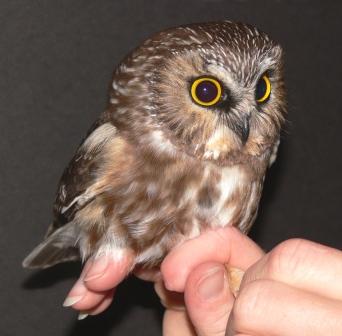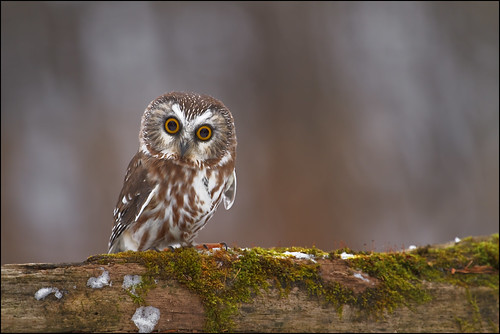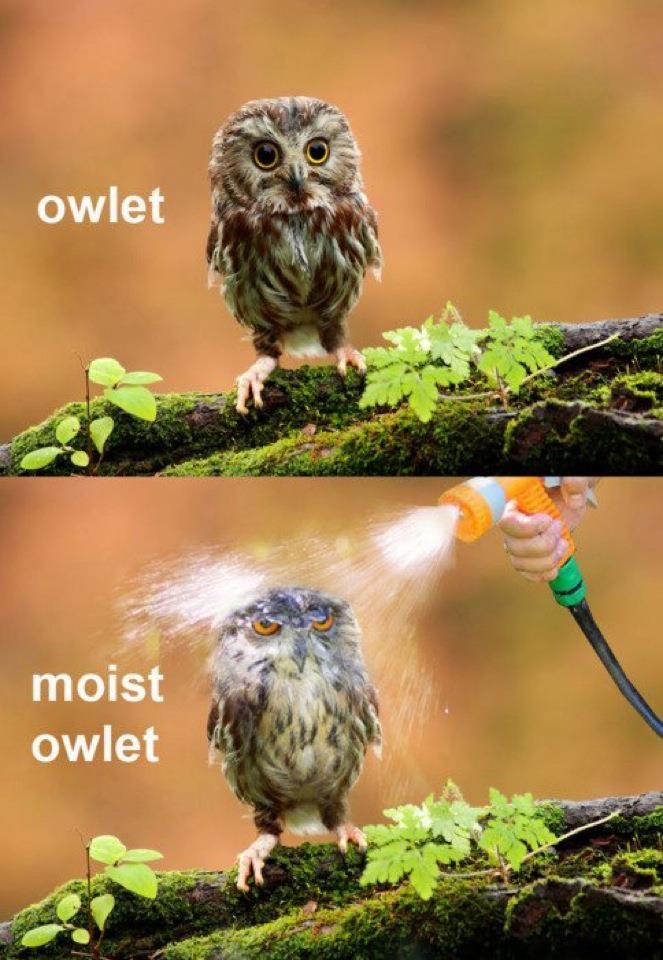Based on the birds being admitted to the RMRP recently, it would have been very timely of me to swap around my article on Saw-Whet Owls (which we admitted two of a few weeks ago), and my article on Boreal Owls (which we admitted one of a few days ago). Alas, while I'm remarkably wise, I am not prescient.
 |
| lloydspitalnikphotos.com |
So, let's learn about Northern Saw-Whet Owls. These birds are the cutest little murder-machines you've ever encountered, kind of like teddy bears armed with knives. They're one of the smallest North American owls, standing just 5-6 inches high, with a wingspan of 18-22 inches, and weighing 2 1/2 - 4 oz (about as much as a quarter to a half cup of water). They are non-tufted owls, with rather large heads in comparison to the rest of their little bodies. They have a distinctive white "Y" shape on their face, and an overall streaked, buffy coloration elsewhere. Their eyes are their most striking characteristic, slanty and bright yellow, and as innocent looking as doe eyes. But at the other end of their body, their arsenal of eight small-but-sharp talons are always at the ready.
 |
| Saw-Whet Owl talons (richmondaudobon.org) |
I've overheard Humans at the RMRP saying, "Saw-Whet Owls have the attitude of a female Golden Eagle packed into a tiny body." It's not an exaggeration. Not only do they have the attitude of a bird willing to fight for its life, they also take on (and take down) prey much larger than they are. While Saw-Whet Owls typically dine on small rodents with a supplementary diet of songbirds and frogs, they don't turn down an opportunity to kill a squirrel, rat, or even a rock pigeon (about 4X heavier than the Saw-Whet Owl).
 |
A picture to show the size of a Saw-Whet Owl. (Please note:
this is a wild bird being held for banding, and this is not how
the RMRP handles birds) guardiansofgahoole.wikia.com |
Immature Saw-Whet Owls look very different from the adults, with a dark, chocolate-brown color on their heads, backs and wings, and a light brown color on their fronts. They still have that clear white "Y" on their faces, though. Saw-Whet Owls typically lay from 3-7 eggs in cavity nests (much like the other small owls we've learned about recently). They fledge after 4-5 weeks, and are sexually mature in under a year. Life moves fast for small birds like these.
 |
| Immature Saw-Whet Owls (wikipedia.org) |
Their common name refers to the sounds they make when alarmed, which apparently sounds an awful lot like a saw being whetted. Never having heard a saw being whetted myself, I'll have to take the Humans' word on this one. The other sounds they make is a long series of "
hoop-hoop-hoop", and they only vocalize like this during breeding season. It sounds like this:
Saw-Whet Owl call
 |
| kewlwallpapers.com |
These birds live in forests with dense areas for nesting. They're year-round residents of the Rocky Mountains and southern Canada, and winter residents in much of the United States. In Northern Colorado, a transition zone between the two ranges, they're most commonly seen passing through on migration. In fact, the RMRP has admitted two Saw-Whet Owls in the past couple weeks, both window-strikes from encountering the large plate-glass windows of beautiful mountain homes as they passed through. One of these birds has already been released to continue on his way, and the other is still in rehab working out some kinks in her flight.
 |
| flickriver.com |
An odd habit of these birds is to remain still and not fly away when they're discovered. They're so adamant about not moving that people can readily approach them, and the owl will just sit and watch. While it's cool from a photographer's perspective, and it allows an excellent chance to closely observe these birds in the wild, please respect its personal space and don't get so close that the bird is forced to fly away. A reader of this blog actually discovered one of these owls in the wild a few weeks ago and encountered this unique behavior. A link to his photo-essay is in the comments section for the
Boreal Owl article. I also recommend checking out that article so you can see the difference between the Saw-Whet Owl and the Boreal Owl, which look quite similar.
On a side note, I'm sure many of you have seen the following popular joke:
The bird in the top image is a Saw-Whet Owl, but you already knew that. The owl in the bottom image is the lower half of the original Saw-Whet Owl, with a very photoshopped head of a much larger, very wet Eagle Owl on top. The Saw-Whet Owl is also the star of the equally popular "Time For Tickles" image:
Now you know.
Back to the serious stuff, there's not a lot of data about the population of Saw-Whet Owls, but it's clear to see from the recent admissions to the RMRP that they face similar threats as the other small owls: window strikes, car hits, and other trauma. The RMRP doesn't see many of these owls, but those that come through the doors here at our main facility are given quality care and the utmost respect, all the way from admit to release.
If you would like to support the RMRP, please use the donation link in the right sidebar. Also, please follow us on
Facebook and
Twitter, and check out our
official website to learn more. Next week's owl (there are only two left!) is the dark-eyed Flammulated Owl. Thanks for reading!









A very nice informational blog. Keep on making such important blog post. Your work is really being appreciated by someone. teddy bear
ReplyDeleteHowever, some hypoid and worm drive designs may not spin their cutting blades at as high of speeds as a direct drive. power tool reviews
ReplyDeleteI have one that has moved into a storage area with room around the top for it to come and go. Right now, it is perching on a non electrified porcelaine light fixture and I would like to put something more natural for it to perch on since it is keeping my rodent population totally controlled. What should I put out there?
ReplyDelete